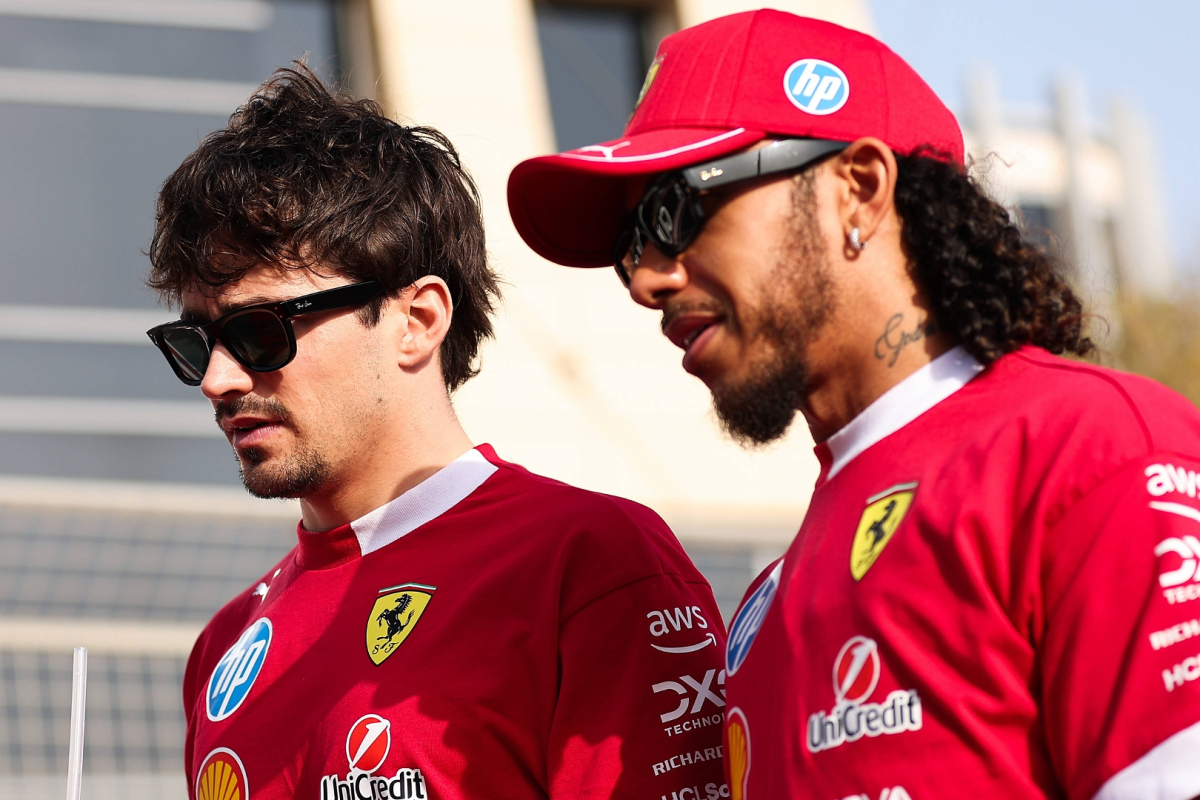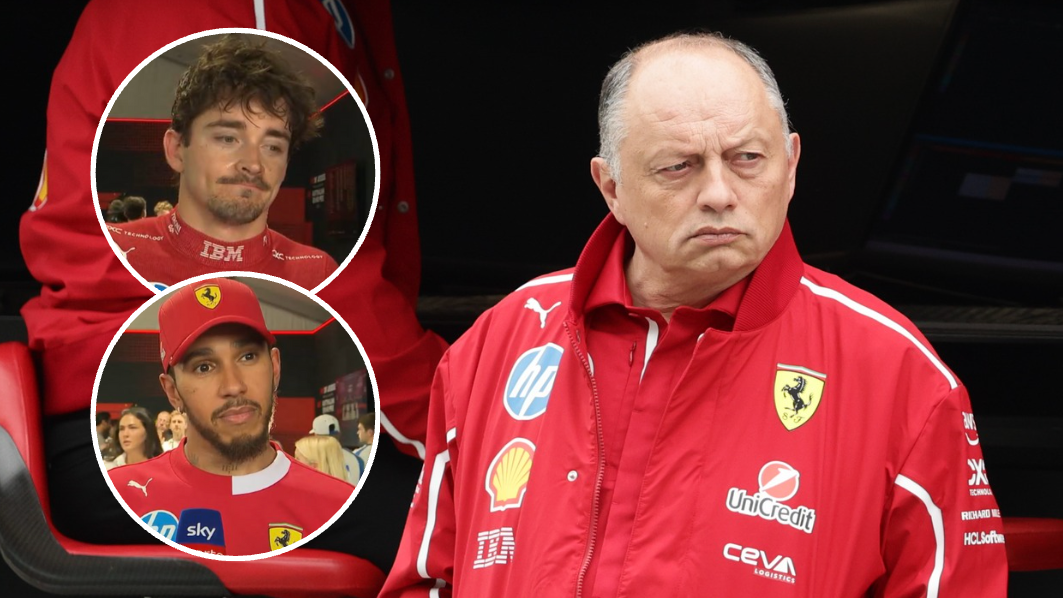The scene in Austin, Texas, was supposed to be a coronation. It was meant to be another battleground in a titanic, season-long war between the two greatest drivers of their eras, united in red. When Lewis Hamilton made his seismic, earth-shattering move to Ferrari for the 2025 season, the world didn’t just expect fireworks; it expected a glorious explosion that would either forge a championship or tear the team apart.
Instead, as the sun beat down on the Circuit of the Americas, the reality was quiet, sterile, and profoundly disappointing.
There was no battle for pole position. There was no internal conflict. There was only a shared, baffled silence. Lewis Hamilton, the 40-year-old seven-time champion, and Charles Leclerc, the Tifosi’s long-anointed golden boy, were left scratching their heads, staring at a timing screen that showed them in eighth and tenth place.
The dream team has become a disaster. And the most shocking part? The two men at its center aren’t at war. They are united in their confusion.

“That was definitely not the pace we were expecting,” a clearly disheartened Hamilton confessed, his words barely masking a season’s worth of frustration. “The car is very, very tough to drive, and this just fell away from us. Eight-tenths is just a mountain to climb.”
Leclerc, standing just meters away, echoed the sentiment, looking utterly lost. “We lost time everywhere,” he stated flatly. “I hope that I’m wrong, but unfortunately, for now, it just seems like it’s the potential of our car. Today was a very poor day.”
This single, bleak weekend in Austin is a microcosm of a 2025 season that has been a catastrophic failure for the Maranello squad. The hype of early 2024, when the announcement of Hamilton’s move sent shockwaves through the sporting world, feels like a distant, naive memory. This was the pairing that was to end Red Bull’s dominance and finally bring a driver’s championship back to Ferrari for the first time since 2007.
It has done neither.
Hamilton’s “challenging debut campaign” has been a brutal reality check. The legendary British driver, widely considered the greatest qualifier in the sport’s history, has not secured a single podium finish all season. His only taste of “victory” was a hollow sprint race win in China back in March. He languishes sixth in the standings, a staggering 211 points behind the new championship leader, Oscar Piastri.
This wasn’t the final, glorious chapter he envisioned. He didn’t leave his spiritual home at Mercedes, a team he built around him, to fight for eighth place. He came to Ferrari to win his record-breaking eighth title, to cement his legacy in the scarlet red of the sport’s most iconic team. Instead, he finds himself in a car that is “very, very tough to drive,” a machine he cannot understand, fighting a battle he is comprehensively losing.
And what of Leclerc? The Monegasque driver was seen as the man sacrificing the most. This was his team. He was groomed by the Ferrari Driver Academy, the man who bled red and carried the hopes of an entire nation on his shoulders. The arrival of Hamilton was a direct threat to his status, his future, and his claim as the team’s number one.

Yet, Leclerc has only had “marginally more success.” He sits one place ahead of his legendary teammate in the championship, holding a 48-point advantage. He has scraped together a few podiums—second in his home race of Monaco, thirds in Saudi Arabia, Spain, Austria, and Belgium. But these are just scraps from the table. In any other context, beating Lewis Hamilton in the same machinery would be a career-defining achievement. In 2025, it’s a hollow victory, a battle for fifth place while others run away with the championship.
Perhaps most damning is that the team isn’t just stagnating; it’s actively getting worse. Both Hamilton and Leclerc have seen their form “deteriorate further” since the summer break. The reset was meant to invigorate the team, to allow them to find answers. Instead, it seems to have deepened the mystery.
Their campaign hit a devastating low with a double DNF at the Dutch Grand Prix. This was followed by a string of painful, anonymous finishes. Hamilton, a man who lives for the spotlight, managed a sixth-place finish at Ferrari’s home race in Monza, followed by consecutive eighth-place finishes in Baku and Singapore. Leclerc fared little better, with a fourth, ninth, and sixth.
This is not a blip. This is a trend. This is a team that is fundamentally lost.
The great irony of the 2025 season is that the one thing everyone predicted—a fiery, toxic, season-long war between two alpha drivers—has been the one thing that hasn’t materialized. The press had their narratives ready, pulling out comparisons to Senna and Prost, to Hamilton and Alonso in 2007. They expected fireworks, political maneuvering, and on-track collisions.

The reality is far more tragic. Hamilton and Leclerc are not at war. They are in the trenches together, staring at an enemy they can’t beat: their own car. Their bafflement is shared. Their frustration is mutual. They are pointing fingers, not at each other, but at a fundamental lack of pace that neither man, for all their collective genius, can comprehend.
When Hamilton talks of an “eight-tenths” gap, he describes it as a “mountain.” Right now, it looks unscalable. The 2025 season is lost. The dreams of the Tifosi, who celebrated Hamilton’s arrival as the coming of a new savior, have turned to dust.
The question is no longer whether Hamilton and Leclerc can coexist. They can. The question is whether Ferrari has trapped two of the greatest drivers on the grid in a machine unworthy of their talents. Has Hamilton’s final, brave gamble to secure his legacy backfired in the most spectacular way possible?
As the team packs up in Austin, there are no answers. Only more questions. The dream team is united, but only in their shared failure, bound by the mystery of a car that simply, devastatingly, is not fast enough.